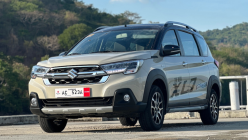Introduced to the Philippine market back in 2018, the Rush is currently one of Toyota Motor Philippines’ popular seven-seater MPVs. Like its rivals, the Rush bears SUV-like styling cues, a relatively high ground clearance, and plenty of interior space. Then again, it uses a rather unique chassis that combines a unibody and body-on-frame build. It shares this quality with the Avanza, but this feature is only found on the Rush within its particular SUV-styled MPV market segment.
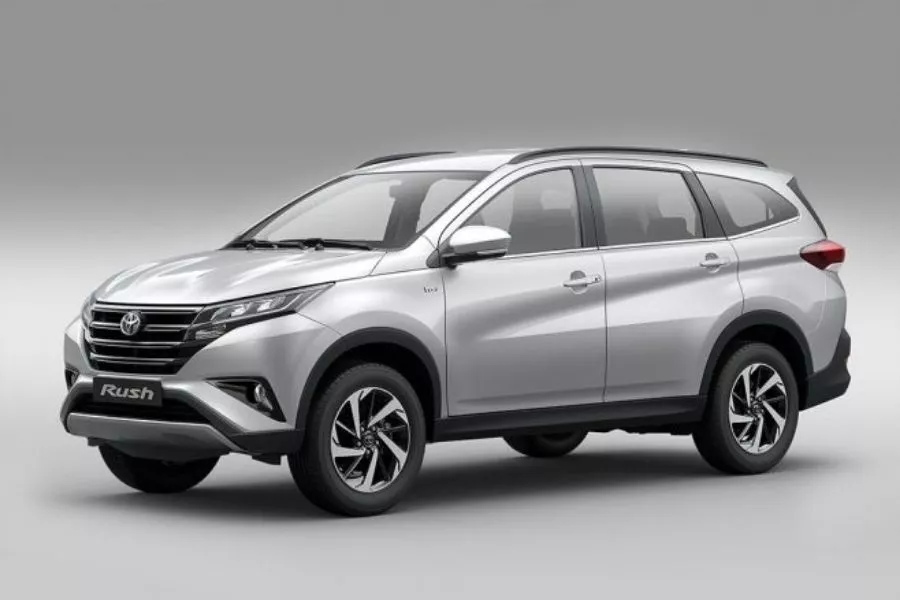
The Toyota Rush is actually an MPV, but it does have half of a body-one-frame chassis
That said, how does the Toyota Rush compare against its SUV-like rivals, specifically the Mitsubishi Xpander Cross, Honda BR-V, and Suzuki XL7?
Toyota Rush: Summary of Specs
Size-wise, the Rush is 4,435mm long, 1,695mm wide, and 1,705mm in height. Its wheelbase is 2,685mm in length, and it also has a ground clearance of 220mm. Depending on the variant, the Rush’s exterior features include LED headlamps, front fog lamps, a roof rail, LED taillights, among others.

As far as styling goes, the Rush tries to emulate its larger SUV cousins
Moving on to interiors, the Rush can seat up to seven occupants. It has three rows, and all of its seats are covered in fabric. The aforementioned occupants are then kept cool with an automatic air-conditioning system (AC), or manual AC depending on the variant. Both AC systems do come with rear vents. The driver is also given a push-to-start button, a tilt- and telescopic steering wheel, etc.
For entertainment, the Rush comes standard with a seven-inch touchscreen with Weblink smartphone connectivity, AUX, USB, and Bluetooth. It is then linked to six speakers for the E variant, and eight speakers for the top-spec G variant.
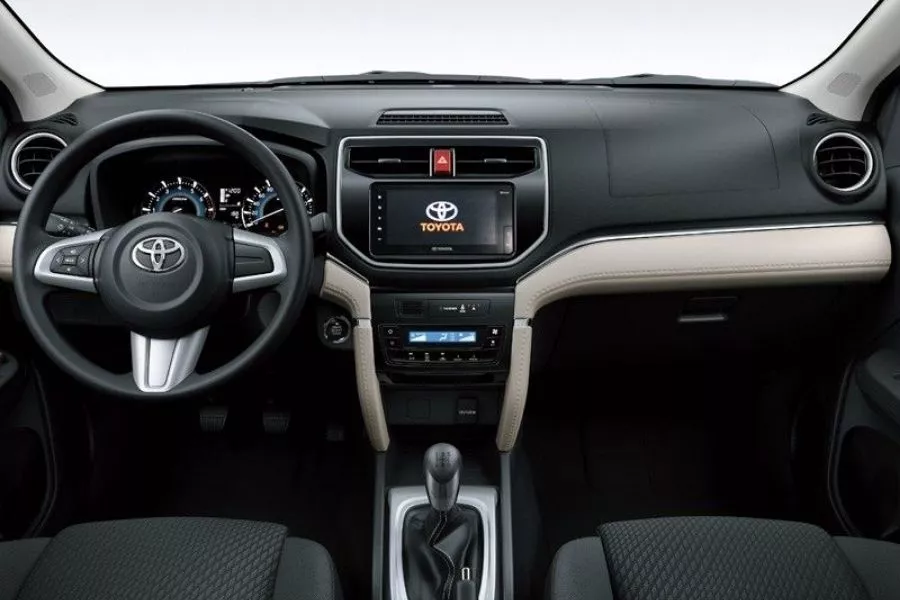
Inside the Toyota Rush
Under the hood, the Rush is powered by a 1.5-liter 2NR-VE inline-4 gasoline engine that’s capable of making up to 102 horsepower and 134 Nm of torque. For the E variant, it either gets a four-speed automatic transmission or a five-speed manual gearbox which sends power to the vehicle’s rear wheels. The G however, is only available with the aforementioned automatic tranny.
Safety for the Rush is handled by six airbags, active stability control, traction control, hill-start assist, anti-lock braking, and ISOFIX.
Currently, the price range for the Rush’s three variants starts from Php 983,000 to Php 1,100,000.
Toyota Rush vs Mitsubishi Xpander Cross
When comparing the Toyota Rush vs the Mitsubishi Xpander Cross in terms of size, the latter is the larger vehicle. Specifically, the Mitsubishi-made MPV’s dimensions measure 4,500mm long, 1,800mm wide, and 1,750mm tall. Its wheelbase is also significantly longer than the Rush at 2,775mm. It also has 5mm more ground clearance at 225mm.
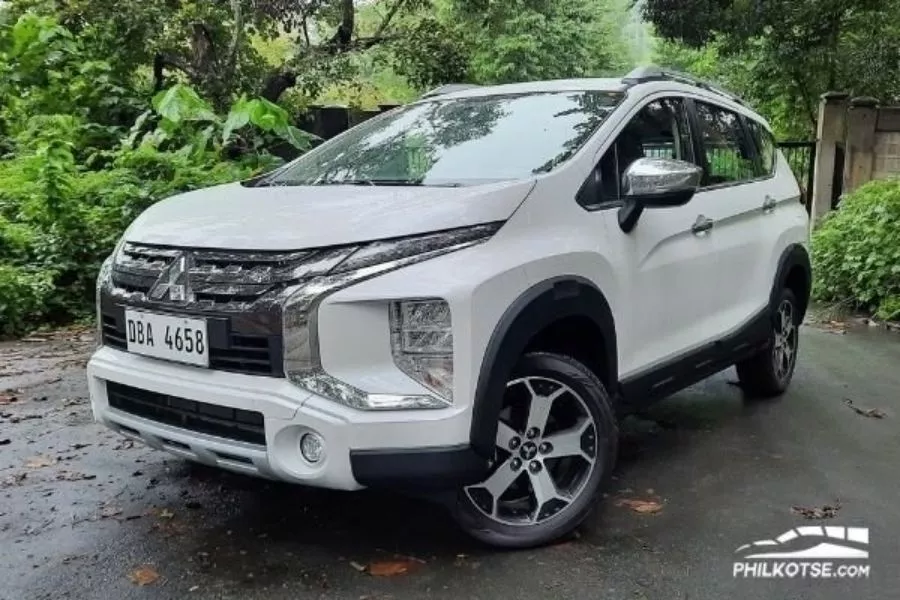
Like its Xpander brothers, the Xpander Cross also gets a futuristic-looking front fascia
As for exterior equipment, it is also better equipped at least when compared with the Rush E AT and MT. It is however on-par with the Rush G with its LED headlamps, LED taillights, and front fog lamps. It also has a roof rail and an abundance of black plastic cladding pieces.
Like the Rush, the Xpander Cross can comfortably seat up to seven. Its interior features are also comparable to the top-spec Rush with its automatic AC with rear vents, six-piece speaker system, cruise control, and push-to-start button. The Xpander’s steering wheel however is tilt-only, whereas the Rush’s also has telescopic adjustment.
For onboard entertainment, the Xpander Cross gets a seven-inch touchscreen. It is as large as a unit equipped on the Rush, and it also comes with smartphone mirroring software, as well as USB and Bluetooth connectivity.
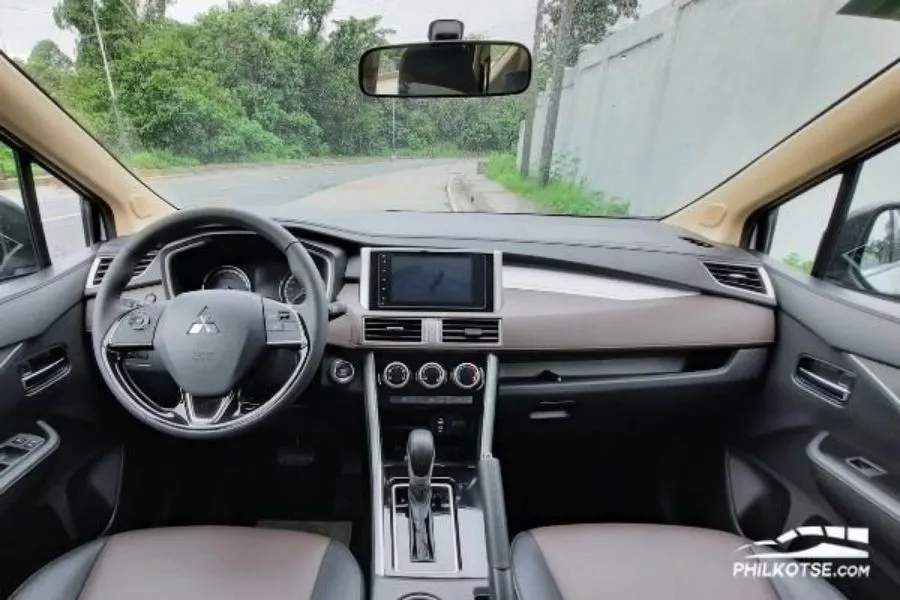
Inside the Mitsubishi-made MPV
In terms of safety, the Xpander Cross has dual front airbags, which is less than what’s available to the Toyota-made model. Other than that, the Mitsubishi-made MPV also has stability control, traction control, hill-start assist, anti-lock braking, and ISOFIX child seat tethers.
Regarding engines, the Xpander Cross uses a 1.5-liter 4A91 inline-4 gasoline mill. At most, this engine can make up to 103 horsepower and 141 NM of torque. Those numbers are slightly different from what the Rush could produce, but we can safely say that they’re just as powerful as each other. As for transmissions, the Mitsubishi-made MPV is also similar to the top-spec Rush G, in that it also uses a four-speed automatic transmission.
However, the Xpander is a front-wheel-drive vehicle, whereas the Rush is a rear-wheel-drive (RWD).
For pricing, the Mitsubishi Xpander Cross can be had for Php 1,225,000.
Toyota Rush vs Honda BR-V
When it comes to size, the Honda BR-V is 4,453mm long, 1,735mm wide, and 1,666mm in height. Its wheelbase is 2,662mm long, and it has a ground clearance of 201mm. Like the Xpander Cross, the Honda-made MPV is larger than the Rush. The Toyota model however, has a longer wheelbase and more ground clearance than the Honda model.

A veteran of the seven-seater MPV market
In comparing the Toyota Rush vs the Honda BR-V when it comes to exterior equipment, the Rush is slightly better as the BR-V only has halogen headlamps. In comparison, the Rush G comes with a pair of LEDs. Like the Rush, the BR-V is also equipped with roof rails, front fog lamps, and LED taillights.
Interior-wise, the BR-V is similar to its Toyota rival as it’s also a seven-seater. It also has fabric seats, and a manual AC with rear vents. Its steering wheel is tilt-only, but it also comes with a push-to-start button.
Moving on to its onboard entertainment system, the BR-V uses a seven-inch headunit with Apple CarPlay, Android Auto, USB, and Bluetooth connectivity. As such, it is better than the Rush’s headunit. But then again, it is linked to four speakers which are two less than the six-piece speaker system on-board the Rush G.
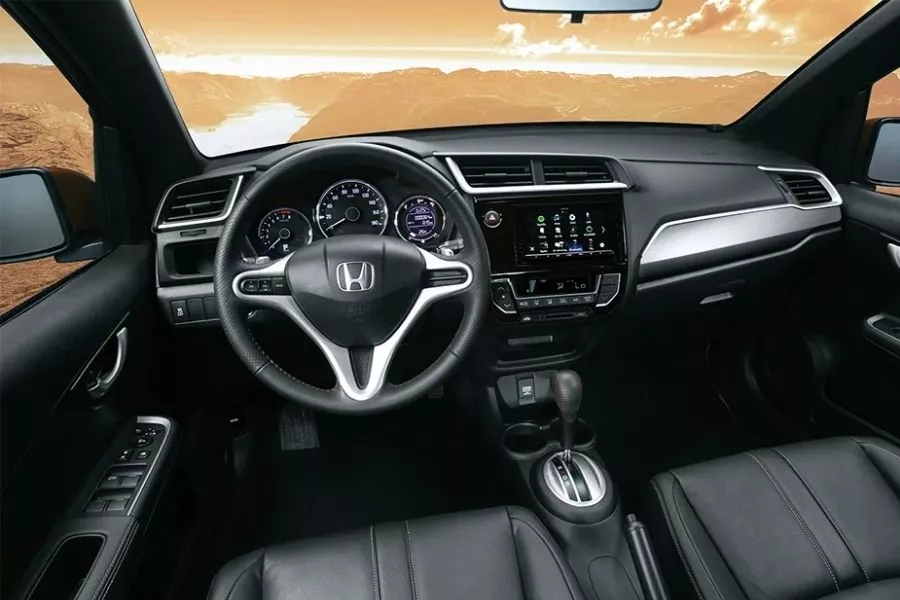
The BR-V's cockpit
With regards to safety, the top-spec BR-V has two airbags. As mentioned above, the Toyota-made MPV has more. The Honda MPV however, also comes standard with anti-lock braking, hill-start assist, stability control, and ISOFIX. It also gets a reverse camera, which is not present on the Rush G.
As for engines, the BR-V is one of the most powerful models in its segment. That’s because its 1.5-liter inline-4 mill can churn out 120 horsepower and 145 Nm of torque. Unlike the Rush, it is a front-wheel-drive model. Also, it is one of the few models within this segment that uses a continuously variant transmission (CVT).
Currently, the 2021 Honda BR-V's price ranges from Php 1,038,000 to Php 1,158,000.
Toyota Rush vs Suzuki XL7
Size-wise, the Suzuki XL7 is marginally larger than the Rush. That’s because it is 4,450mm long, 1,775mm wide, and 1,710mm in height. Its wheelbase meanwhile measures 2,740mm, which is significantly longer than the Toyota model. It does have less ground clearance at 200mm.
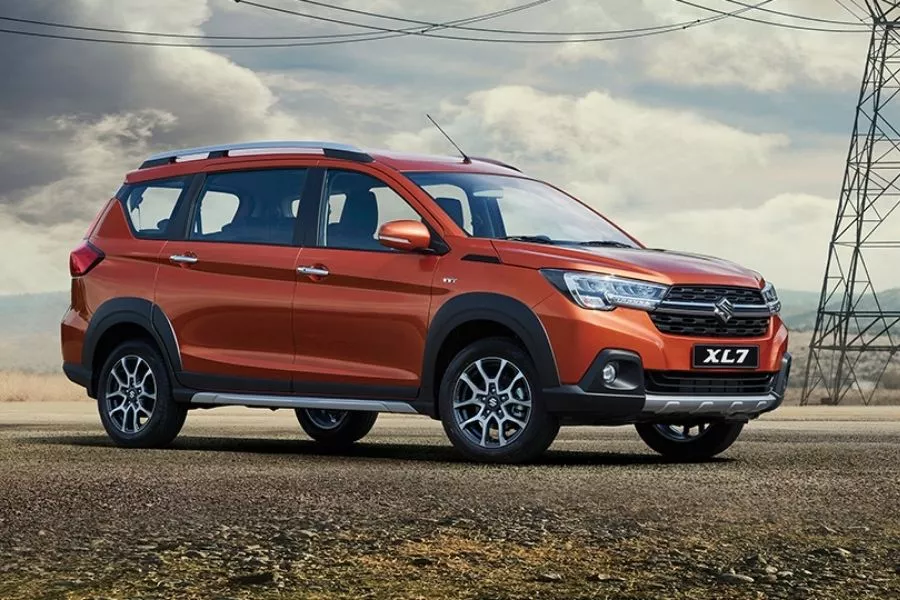 The XL7 is the beefed-up version of the Suzuki Ertiga
The XL7 is the beefed-up version of the Suzuki Ertiga
In comparing the Suzuki XL7 vs the Toyota Rush when it comes to exterior features, both however are on-par with the top-spec Rush G. To be specific, the Suzuki-made MPV also has LED headlamps, LED taillights, front fog lamps, and roof rails.
Moving on to interiors, the XL7 has a slightly better cooling system as it is automatic. It also has a larger 10-inch touchscreen, which in itself has more connectivity options in the form of Apple CarPlay, Android Auto, USB, and Bluetooth. And just like the Rush, the XL7 can seat seven, and it also has fabric seats.
However, the XL7’s speaker system is comparable to the Rush G, as it also has six. For the driver, the Suzuki model also offers less adjustability than the Rush with its tilt-only steering wheel. Although, it is also equipped with a push-to-start button, and it also gets a rear parking camera.
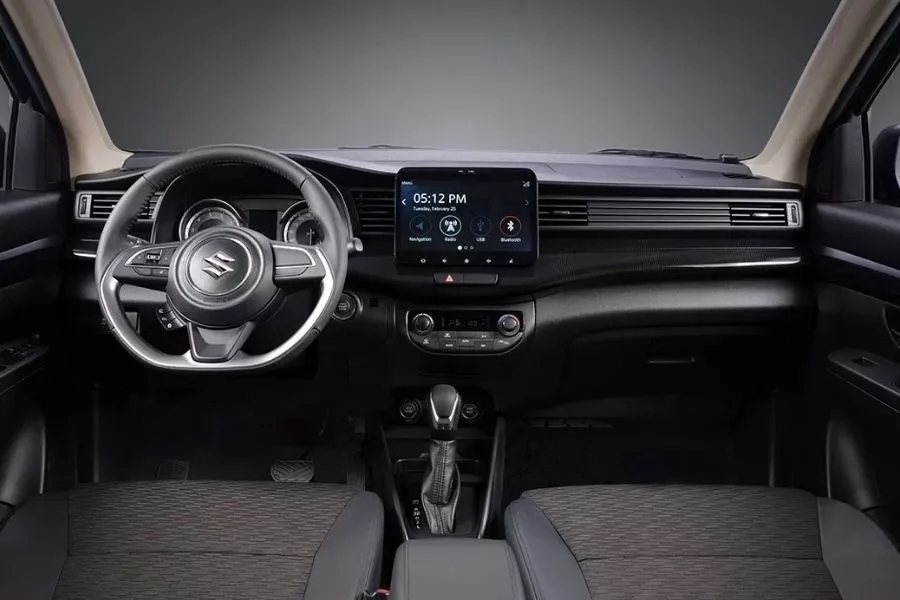
The XL7's interior
For safety, the XL7 is kitted out with dual front airbags, hill hold control, stability control, ISOFIX, as well as anti-lock braking. The Rush G has more airbags, but otherwise the Suzuki is on par with the Toyota.
Powering the XL7 is a 1.5-liter K15B inline-4 gasoline engine, which can make up to 103 horsepower and 138 Nm of torque. Power is then sent to its front wheels through a four-speed automatic transmission. It is as powerful as the Rush and the Xpander Cross, and it even uses a similar transmission system. Unlike the Rush, it is a front-wheel-drive model.
As of the moment, the Suzuki XL7 GLX AT has a price tag of Php 1,073,000.
For more comparisons between car models, car buying and selling guides, and car maintenance tips, keep it here on Philkotse.com.
Know more about Toyota Rush 2026

The Toyota Rush 2025 is Toyota Motor Philippines (TMP)’s entry into the local competitive multi-purpose vehicle (MPV) segment. Considering its relatively large size and affordable pricing, the MPV is regarded by some as an entry-level SUV for the Japanese car brand. Toyota Rush Price in the Philippines is P1,208,000 with only one 1.5 G-RS variant. Under the hood, it is powered by a 1.5-liter 2NR-VE inline-4 DOHC gasoline engine that makes 102 hp and 134 Nm of torque. This engine can be connected to a 4-speed automatic transmission. Dimensions-wise, the Rush spans 4,435 mm in length, 1,695 mm in width, and 1,705 mm in height. In the local market, this vehicle from Toyota Philippines competes against the likes of the Mitsubishi Xpander and Honda BR-V.
There are many SUV-like features that the Toyota Rush offers such as a relatively high ground clearance rated at 220 mm and its new seating configuration that makes seven as standard across all variants. It is considered one of the best value for money, especially for those who wish for a relatively affordable family car. In other markets, the Toyota Rush is called the Daihatsu Terios due to the Japanese automaker's partnership with Daihatsu Motor.
>>> New and used Toyota Rush 2025 for sale in the Philippines
Toyota Rush Launch
The updated Toyota Rush was introduced by TMP last November 2020 which now offers a 7-seating configuration as standard. The Japanese carmaker shared that a 7-seater MPV is a favorite family vehicle among Filipinos so it wanted to add a third row of seating for all variants.
In 2022, TMP replaced the top-spec Rush G with the sportier GR-S variant. The updated 7-seater MPV is currently competing against the likes of the Mitsubishi Xpander, Honda BR-V, and Maxus G50.
Toyota Rush Exterior
The Toyota Rush is currently riding on the exterior design of the third-generation Daihatsu Terios. It comes with an SUV-like and more aggressive road presence as it is inspired by the design of its 7-seater midsize SUV sibling, the Toyota Fortuner.
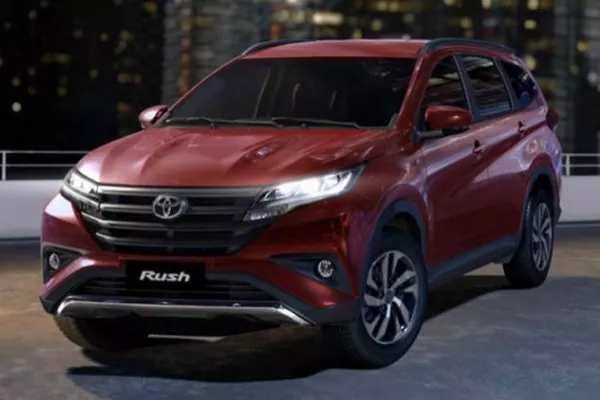
The exterior design of the Toyota Rush is inspired by the Toyota Fortuner
All variants of the Toyota MPV are installed with LED headlights and taillights (with LED guidelines), a rear spoiler, a shark-fin antenna, and more. E variants get chrome radiator grille and 16-inch alloy wheels, while the top-ranging GR-S variant comes with GR-S treatment and 17-inch alloy wheels.
Toyota offers the Rush six color options: White, Bronze Mica Metallic, Dark Red Mica Metallic, Bordeaux Mica, Silver Mica Metallic, and Black Metallic.
Toyota Rush Interior
As said earlier, all variants now come with a 7-seating configuration which should be practical for those who want to own a relatively large car but don’t want to spend a hefty amount of cash. The 50:50 third-row seats can be folded to offer more cargo space.
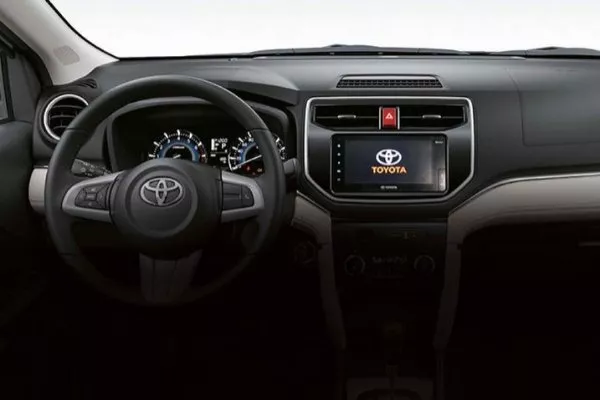
Another notable feature inside the Toyota Rush is the white accents on the doors and dashboard decorated with faux stitches
The interior for the lower E variants is installed with a urethane 3-spoke steering wheel, shift lever, and knob. Meanwhile, the top-ranging GR-S variant benefits from leather materials on the said interior parts and three accessory outlets as compared to just one for E variants.
>>> Get best deals of the Toyota Rush for sale in the Philippines at amazing prices
Technology & Safety Features
The Toyota Rush is installed with a 7-inch infotainment screen across all variants which supports CD/MP3, AUX, USB, Bluetooth, and Weblink Connectivity for iOS/Android. Sounds are sent off to six speakers for E variants, while the top-of-the-line variant gets eight.
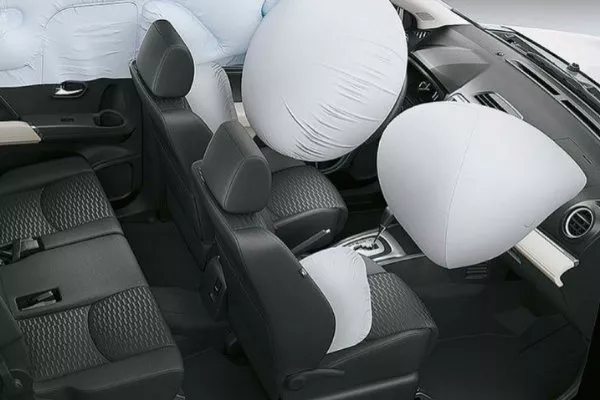
Toyota Rush's airbags
As for safety, the updated model still offers the same features such as six airbags, an anti-lock braking system (ABS) with electronic brakeforce distribution (EBD), traction control, hill start assist, emergency stop signal, and ISOFIX tethers. Keyless entry is used for E variants and smart entry is the go-to for the GR-S variant.
Platform & Chassis
The Toyota Rush is designed with a ladder-frame chassis similar to the Toyota Avanza. It is built on the Daihatsu F800, the platform of the current Daihatsu Terios. This platform configuration, including the 220 mm ground clearance, solidifies the model’s reputation as a small yet rugged SUV.
To further improve stiffness, the front suspension is handled by a McPherson Strut, and a four-link suspension for the rear setup. As for the brakes, the 7-seater MPV is installed with disc brakes on the front wheels and drum brakes for the rear wheels.
Engine & Drivetrain
Under the hood, the Toyota Rush is powered by a 1.5-liter 2NR-VE Dual VVT-i gasoline engine that can put up 102 hp and 134 Nm of torque. This is the same engine that the Toyota Avanza and Veloz use.
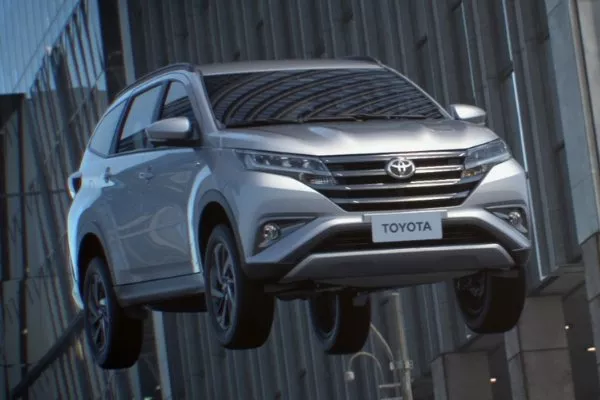
Powering the Toyota Rush is a 1.5-liter 2NR-VE Dual VVT-I gasoline engine
For the base E variant, it pairs the engine with a 5-speed manual transmission. Meanwhile, the rest of the two variants of the model use a 4-speed automatic transmission. The power is sent to the rear wheels thanks to its rear-wheel-drive (RWD) drivetrain.
>>> Also check out:
- What we'd like to see from an updated Toyota Rush 2020 Philippines
- Sib Duel: Toyota Rush vs Innova MPV Specs Comparison
Toyota Rush 2025 Price List
| Variant | Price |
|---|---|
| Toyota Rush 1.5 GR-S | ₱1,208,000 |
Toyota Rush FAQs
1. Does Toyota Rush Philippines have cruise control?
No, it doesn't. No variants of the Rush come with cruise control.
2. How much will the Toyota Rush 2025?
The Toyota Rush is priced at P1,202,000.
3. What engine will the Toyota Rush 2025 use?
Toyota Rush is operated by a gasoline engine (1.5L) with a maximum output of 102 horsepower and 134 Nm.
4. What is the length of the Toyota Rush Philippines?
The length of the Toyota Rush is 4335mm, while the width is 1695mm.
5. Is the Toyota Rush a reliable car?
Yes, it absolutely is. The Toyota Rush is one of the best-selling SUVs in the Philippines market because it offers a perfect combination of performance, style, and comfort.
₱ 1,012,000 - ₱ 1,176,000
ExploreRecent posts
- Latest Toyota Rush Price Philippines 2026 Sep 23, 2025
- Toyota Philippines price List 2026 May 10, 2023
- Why is the Toyota Rush such a hit to Filipino car buyers? Apr 15, 2021





